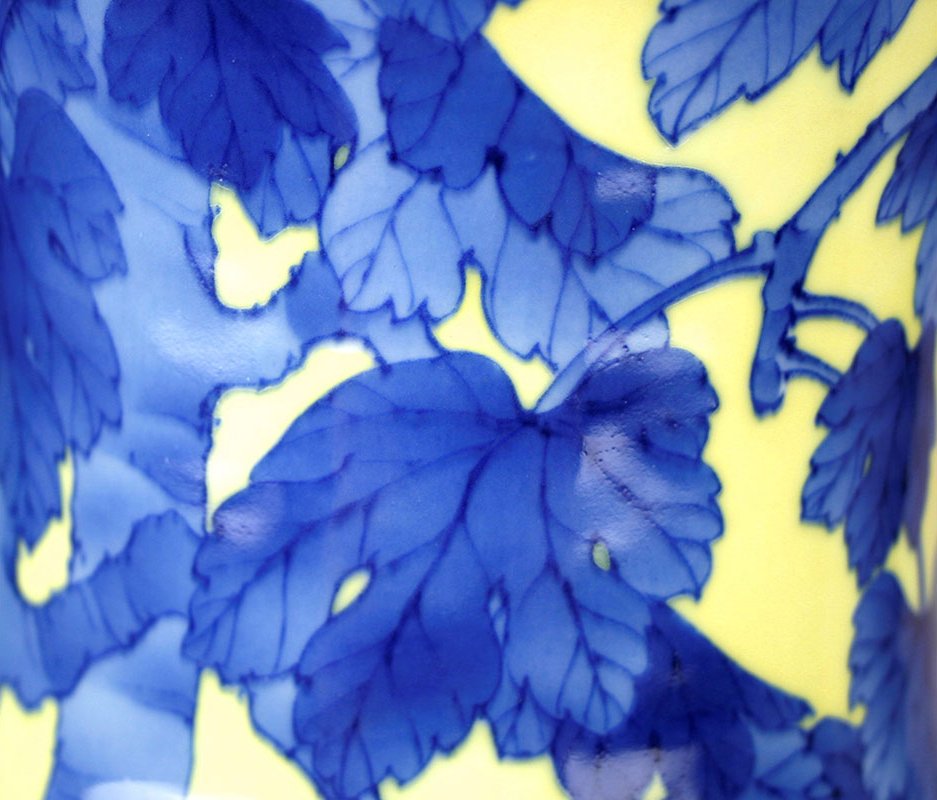MEIJI-TAISHO
MAKUZU KOZAN II, LARGE PORCELAIN VASE WITH CHINESE PARASOL TREE & SPARROWS
Vase in a massive baluster form with a flaring rim, decorated in blue and pale lemon-yellow with a design of sparrows beneath a Chinese parasol tree. Of porcelain, decorated in under-glaze blue and over-glaze enamels. Signed on the reverse in under-glaze blue by the artist: Makuzu Kozan Sei or Made by Makuzu Kozan (Makuzu Kozan II, the go or art name of Miyagawa Hanzan, 1859 – 1940). With the original carved rosewood stand. Taisho era, circa 1912 – 1926.
With a fitted wood, period storage box, bearing a paper label (partially torn away): Oyu Godo no Zu, Miyagawa Kozan Kinsei or Yellow Glaze Chinese Parasol (or Blue Paulownia) Tree Design (Vase), Finely Made by Miyagawa Kozan, and then the date it was given: Showa Go-nen, Roku-gatsu or Showa (era) 5th Year (1930), June, and either Ju-ni or Ju-san… or either the 12th or 13th (day). By report, this was an Imperial gift to the recipient, whose family name has no doubt been removed with the missing portion of the label. This also explains the later dating on the box, which records the date it was bestowed rather than made.
Both Kozan I and II were involved in running the ceramics studio in the early part of the century. Since both were what we would today think of as “art directors” supervising the work of numbers of craftsmen working under their direction, as well as talented potters in their own right, it can be very difficult to differentiate one generation’s work from the others’ (especially with regard to material dating from late in the first generation’s lifetime). Both designed and signed pieces during the same period, and sometimes neither had a hand in making the actual piece. During this period, the Imperial Household Agency ordered numbers of high-quality (and often large-scale) pieces from the Kozan studio to be given as Imperial gifts.
Makuzu Kozan I was one of the most prominent art potters working during the Meiji era. He took over the family ceramics business in 1860 at the age of 18. In 1870, he moved to Yokohama with his family and four apprentices, and he opened the Makuzu kiln the following year. In 1876, he participated in an international exhibition for the first time with the Philadelphia Centennial Exposition. The following year his work won the Ryumon Imperial Award at the Dai Ikkai Naikoku Kangyo Hakurankai (1st National Industrial Exposition) in Ueno, Tokyo. In 1878, his work won a gold medal at the Paris Exposition Universelle. In succeeding years Kozan continued to exhibit widely at international and domestic venues, and his work continued to garner prizes. In 1882, Kozan I formally made his son Miyagawa Hanzan head of the family business, though the two continued to collaborate until the death of the father in 1916. Kozan I became a Teishitsu Gigeiin or Imperial artist in 1896.
Makuzu Kozan II (or Miyagawa Hanzan) was the son and heir of Makuzu Kozan I. In 1882, he was formally made head of the family business by his father, though the two continued to collaborate until his father’s death in 1916. Kozan II exhibited work at the Imperial art exhibitions, beginning with the 8th Teiten in 1927, and returning to the 9th, 11th, 12th, 13th, and 15th. He also showed at the autumn Bunten Kansaten in 1936, at the 1st – 3rd Shin-Bunten from 1937 – 1939, and at the Hoshukuten in 1940. His heir, Makuzu Kozan III died in the aerial bombings of Yokohama when the Makuzu kiln and showroom were destroyed.
For another blue and yellow vase with sparrows under banana leaves with a similar signature, c.f. Bridging East and West: Japanese Ceramics from the Kozan Studio, page 37, number 12.
Kozan pieces of this scale and quality were made in relatively few numbers and remain quite rare. A magnificent example of the Kozan studio’s work from the golden age of Imperial Japan.
Makuzu Kozan II, Large Porcelain Vase with Chinese Parasol Tree & Sparrows
Artist Name: Makuzu Kozan II
Period: Meiji Taisho
Mediums: Porcelain
Form: Vase
Origin Country: Japan
19 5/8” high x 11 ¼” diameter
This piece is no longer available.




